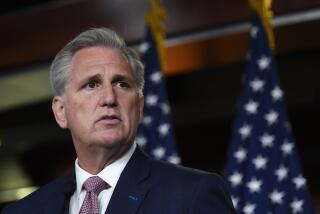Brady Debt Plan Faces Challenges at Cabinet Level : Critics Doubt Proposal Would Provide Lasting Relief for Third World
- Share via
WASHINGTON — Treasury Secretary Nicholas F. Brady’s controversial new plan for reducing the Third World’s debt burden will go before the Cabinet this week to face vigorous challenges from the State Department and the White House National Security Council.
The proposal, unveiled Friday without a full go-ahead from the White House or other interested government agencies, seeks to aid Latin American debtor countries by coaxing commercial banks to negotiate reductions in the principal and interest paid by these countries, using assistance from the World Bank and the International Monetary Fund.
Now, both the State Department and the National Security Council are preparing to raise the issue again at a Cabinet-level review session that could take place as early as today or Wednesday. It was not clear whether President Bush will attend the meeting, although some said it is a growing possibility.
The Federal Reserve has also expressed reservations not only about the proposal but also about the Treasury’s day-to-day handling of the Latin American debt situation during Brady’s six months in office.
Could Be Setback
Administration policy-makers said it is almost certainly too late for Brady to retract the plan now that it has been made public, but they said the Cabinet-level review group may decide that the Treasury measures should be “supplemented” by other proposals designed to bolster Brady’s scheme.
Even so, such a decision would be a major setback to Brady, who already has suffered some serious backfires involving his handling of the Administration’s savings and loan rescue plan and recent fluctuations in the value of the dollar.
Essentially, the opponents object to the plan on two grounds:
First, they question how much the Third World’s debt burden actually can be reduced under the new plan. The Treasury has refused to provide any estimates, but analysts say that each $1 in actual debt reduction trims a country’s debt payment by only about 10 cents.
Second, they doubt whether debtor countries would be able to resolve their current financial problems--let alone spur economic growth--merely by reducing their current debt burdens without also borrowing more money from banks.
Would Reduce Lending
Those criticizing the plan fear that if the scheme proves as inadequate as they believe, it could prompt some Latin American countries to consider stopping paying their debts and closing off their economies--leading to even worse inflation and political unrest.
Treasury officials concede that lending by banks, which has fallen off sharply in the past few years, would be even more “modest” under the Brady plan.
It is mainly the cutback in bank lending that brought on the breakdown of the previous U.S. debt strategy, which had sought to prod banks into stepping up their lending in exchange for new efforts by the debtor countries to overhaul their domestic economies.
But Treasury officials insist that the plan is carefully thought out and workable. They argue that debtor countries can reverse capital flight if they try hard enough and do not need much new lending. New lending, they say, would only increase debt burdens.
Critics also doubt that debtor countries could make up the rest of their financing deficits by luring back Latin American domestic capital that has poured out to more attractive investments in the United States, Europe and Japan.
Some critics also argue that the plan would establish a bad precedent by using greater amounts of “public money”--from the World Bank and the International Monetary Fund--a step that has been taken only in a limited way in the past.
And they fear that the proposal could be viewed abroad as a withdrawal of U.S. leadership in dealing with the global debt situation, allowing Japan to fill the void by providing extra loans to bolster the IMF and World Bank monies.
The Brady plan calls for Japan to play a larger role in easing the plight of debtor countries, and Tokyo announced Friday that it would provide “parallel” loans to deserving debtors to bolster the guarantees from the IMF and World Bank.
Political Unrest
Brady’s proposal comes at a time Latin American democracies are facing serious new political unrest over the debt issue.
Recent rioting in Venezuela resulted in some 300 deaths, and governments in Brazil and Argentina are encountering major political challenges by leftists. The Treasury on Friday approved a $450-million temporary loan to Venezuela to help tide the country over.
U.S. officials said Brady rushed his plan out in part to help dampen growing political unrest in the region. But reaction in most Latin American governments has been lukewarm, with officials insisting on seeing details of the plan before they decide whether to endorse it.
Some U.S. strategists fear that the Brady plan will prove inadequate and fall too far short of expectations, prompting a backlash among Latin Americans. They say that, in turn, would only defeat the basic purpose of the plan--to help calm tensions and restore growth.
More to Read
Sign up for Essential California
The most important California stories and recommendations in your inbox every morning.
You may occasionally receive promotional content from the Los Angeles Times.













